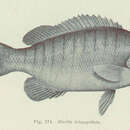en
names in breadcrumbs


The parore (Girella tricuspidata) also known as luderick, black bream, black snapper or blackfish is a species of marine ray-finned fish, a sea chub from the family Kyphosidae which is found in the southwestern Pacific Ocean off Australia and New Zealand. Parore or paraore is the common name in New Zealand but in Australia luderick is preferred.
The parore was first formally described as Boops tricuspidatus in 1824 by Jean René Constant Quoy & Joseph Paul Gaimard with the type locality given as "Shark Bay, Western Australia".[2]
The parore has a moderately deep, compressed, oval shaped body with a thin caudal peduncle, It has a small head which has a slightly convex forehead, and small eyes. The mouth is small and does not extend as far as the eye. The jaws have an outer row of overlapping, flattened, tricuspid teeth beside a wide band of teeth of similar shape but which are tiny. Much of the body is covered im moderately small ctenoid scales and there is an arched lateral line, made up of 48-51 pored scales, which is parallel to the dorsal profile. It has a continuous dorsal fin which has no demarcation between its spiny and rayed parts. The spiny part has 14-16 spines and is one and a half times to almost twice as long as the soft rayed part which contains 11-12 soft rays. The spines in the middle of the dorsal fin are the longest and are just a little bit shorter than the soft rays, which get shorter towards the tail. The anal fin is similar to the soft-rayed part of the dorsal fin, contains 3 spines and 11-12 soft rays and is situated opposite it. The caudal fin has 17 rays, is very large and broadly forked. The pectoral fins are small, with 16 rays the uppermost being the longest, and the pelvic fins are small, containing a spine and 5 rays.[3] The maximum size recorded is a fork length of 71 centimetres (28 in), although total lengths around 35 centimetres (14 in) are more normal. The maximum published weight is 4 kilograms (8.8 lb).[1] The colour and pattern of the parore is dark greenish-grey dorsally and silvery grey on the flanks and ventrally and belly. There are around 11 thin dark vertical bars underneath the dorsal finwhich fade ventrally. The head and pectoral fins are sometimes yellowish in colour but the fins are usually the same colour as the part of the body they are nearest to.[3]
The parore occurs off eastern Australia and New Zealand. In Australia it occurs from Mackay, Queensland,[3] to east of Adelaide in South Australia and off most of Tasmania.[4] In New Zealand it occurs on both the east and west coasts of the North Island from the North Cape to the Cook Strait.[5]

Parore are found in shallow coastal and estuarine waters where the frequently congregate in large schools in the vicinity of rocky outcrops and jetties. The small juveniles use seagrass beds to hide from predators.[3] The species use their small sharp, incisor-like teeth for grazing on seaweed and algae such as Enteromorpha intestinalis, Ulva lactuca, Ulva intestinalis and sea cabbage, and use a band of crushing teeth which are used to grind algae. While primarily consuming algae, the species is an opportunistic omnivore, feeding on other food items like small crustaceans, pipi, mussels and worms.[4][6] As parore mature, they congregate in large shoals and the adults form 'runs' from estuarine waters and coastal lakes into the sea. The fish spawn in the surf zone and mouths of estuaries,[1] spawning takes place in the winter.[7]
The species schools during the daytime, and at night hides in sheltered areas, camouflaging themselves by turning a brown colour.[6]
Parore are a traditional food of Māori, especially the Te Tai Tokerau Māori tribes of Northland. The fish were often caught using nets that dredged the bottoms of harbours.[6] During the early colonial period of New Zealand, the fish developed a bad reputation among European New Zealanders, with most people believing it to have a terrible taste. The fish was detested by fishermen, as the fish's spines would tangle and tear nets. Over time this perception has begun to change, with fishmongers selling parore under the name black snapper.[6]
While disliked in New Zealand, parore is a very popular fish in Eastern Australia, being one of the most important commercial fish at different points of the 20th Century.[6] In modern times, parore are fished for commercially in New South Wales[3] and in New Zealand they are landed as a bycatch in the grey mullet fishery.[5] The fish are sold fresh.[1] They are a popular quarry for recreational fisheries in Australia and can be caught of seaweed under a float or artificial wee fly,[4] less so in New Zealand where they appear to be mainly caught by recreational fishermen targeting other species.[5]
The parore (Girella tricuspidata) also known as luderick, black bream, black snapper or blackfish is a species of marine ray-finned fish, a sea chub from the family Kyphosidae which is found in the southwestern Pacific Ocean off Australia and New Zealand. Parore or paraore is the common name in New Zealand but in Australia luderick is preferred.